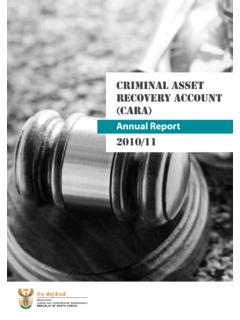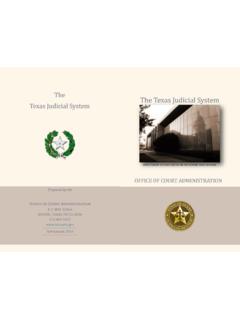Transcription of Adult Criminal Justice System Reforms: 1993 – Present
1 Texas Criminal Justice Coalition | 2017 | 1 Adult Criminal Justice System Reforms: 1993 Present 1993 Birth of the State Jail: State jail System is created to divert individuals with low-level drug offenses from long sentences in TDCJ prisons. State jails are conceptualized as a back-up sentence for individuals who do not comply with community supervision. [Over next several years, however, tens of thousands of Texans with low-level drug offenses are sentenced directly to state jail, serving, on average, over one year and undermining original intent of state jails.] 2001 Landmark Defense Policy & Anti-Racial Policing Policy Passed: Texas enacts Fair Defense Act, which sets framework for improving indigent defense policies in Texas and, among other things, establishes a Task Force on Indigent Defense (now called the Texas Indigent Defense Commission). Governor also signs law requiring Texas law enforcement agencies to develop departmental policies on racial profiling, and compile annual reports on who they stop and search, by race.
2 2003 Preliminary Sentencing reform : Shift from tough-on-crime to smart-on-crime sentiment begins. Filed policies promote use of progressive sanctions for drug offenses involving possession of small amounts of certain controlled substances (signed into law), shortened and strengthened probation term lengths, and stronger treatment infrastructure. But state budget shortfall results in devastating cuts to probation, treatment, and parole driving prisons to breaking point. 2005 Diversion Funding: Mass mobilization of individuals advocating for smart-on-crime reforms results in passage of policies that increase accountability for drug task forces and increase accessibility to identification cards for previously incarcerated individuals, while also allocating additional funds for probation. January 2007 Alarming Prison Projections: Texas faces projected prison population increase of up to 17,000 inmates by 2012 (in addition to nearly 6,000 beds added between 2004 and 2007) if Texas pace of incarceration continues.
3 2007 Legislative Session Justice Reinvestment: Rather than agreeing to spend $ billion over five years on new prison construction and operations, policy-makers work collaboratively and diligently to reinvest fraction of this amount $241 million in probation, parole, treatment beds, etc. 2011 Prison Closure: Historical shifts result in Texas first prison closure (Sugar Land Facility). 2011-2012 Sunset Review of Criminal Justice Agencies: Sunset Advisory Commission reviews Texas Department of Criminal Justice , Community Justice Assistance Division, Parole Board, and other agencies. Advocates call for major improvements in all areas. 2003-2017 Smart-on-Crime Policy Passage & Implementation: 130 new crime-reduction strategies positively impact the Criminal Justice System , resulting in taxpayer savings and falling crime rates in Texas. Texas is seeing safe reductions in incarceration levels at state and county levels, investments in treatment and diversion programs, progressive sanctions for drug offenses, increased reliance on risk assessments to inform probation conditions, reductions in penalties across property offenses, greater emphasis on indigent defense delivery and prevention of wrongful convictions, higher parole approval rates, and reentry measures that help people avoid further System involvement.
4 2013 Facility Closure Approved: State officials approve closure of two private facilities, reflecting continued shift in attitude among Texas leadership, amidst falling crime rates and better evidence of alternatives. 2015 Major Penalty Reclassification: For first time in 22 years, Texas updates monetary thresholds associated with property offense penalties, leading to significant reductions in admissions to state jails for theft, and saving millions. 2017 Additional Facility Closures: Legislature largely deprioritized Criminal Justice reform during 2017 session, but budget designates four correctional facilities for closure, including one prison, one state jail, one intermediate sanction facility, and one pre-parole transfer facility. This follows 2016 closure of another intermediate sanction facility. Texas crime rate has fallen 30 percent to a level not seen since late 1960 s, while incarceration rate has fallen 20 percent. Texas Criminal Justice Coalition | 2017 | 2 Juvenile Justice System : 2005 Present Pre-2005 Punitive Approach to Youth: Juvenile Justice is back-burner issue in Texas.
5 2005 Preliminary Youth Justice Efforts: Two juvenile Justice bills are filed (addressing youth length-of-stay requirements, lack of cultural competence in treatment programs and among field staff, and lack of independent investigation of abuse and neglect in Texas Youth Commission [TYC]). Bills die in committee. 2006-2007 Public Outcry for reform to Address Abuse: Intense media and governmental scrutiny expose abuse and violence taking place in TYC. Spring 2007 Swift Legislative Response: State leaders effect immediate change in TYC leadership and launch joint investigative committee. May 2007 Sweeping Policy reform : Policy-makers pass omnibus reform legislation ( 103) with unanimous bipartisan support. Legislation contains more than 150 specific reforms for TYC to accomplish. 2008 Continued Scrutiny and Resource Reallocation: Texas juvenile Justice agencies undergo Sunset Advisory Commission review. These include TYC, Texas Juvenile Probation Commission (TJPC), and Office of the Independent Ombudsman (OIO).
6 Resulting Sunset legislation redirects significant amount of funding toward rehabilitation programs operated by county juvenile probation departments, and continues TYC and TJPC as stand-alone agencies subject to two-year probationary period. 2011 Legislative Session Agency Merger through Sunset Process: Senate and House budgets reduce TYC s institutional capacity, calling for closure of up to three facilities. New Sunset legislation will merge TYC and TJPC into new Texas Juvenile Justice Department and redirect currently incarcerated youth to juvenile probation System or to remaining lock-ups. June 2011 Facility Closures: Three TYC facilities close and two are consolidated, resulting in transfer of approximately 400 youth; most relocate to one of six remaining state facilities, with few released into community. December 2011 New Youth System : Texas Juvenile Justice Department (TJJD) begins operations, with oversight over probation and corrections System .
7 2012 Ongoing Monitoring of New System : Advocates continue to monitor implementation of 2011 Sunset legislation at both state and county levels. 2007-2013 Smart-on-Crime Policy Passage & Implementation: More than 50 new strategies positively change course of juvenile Justice , resulting in more humane treatment of Texas System -involved youth. August 2013 Facility Closure Vote: State officials approve closure of secure facility for mentally ill youth; advocates monitor youth transfers. 2015-2017 Major Reforms: Texas policy-makers pass laws that move TJJD to a regional model that will keep youth closer to home in lieu of commitment to state facilities; expand jurisdiction of Office of the Ombudsman; and require automatic juvenile record sealing or permanent record destruction in certain circumstances to reduce future barriers to education, employment, housing, and other services. November 2017 Continued Incidents of Abuse: Reports uncover abuse, neglect, and sexual misconduct at Gainesville State School, prompting advocates and some lawmakers to demand reform .
8 TJJD set to hire new Executive Director, who will be tasked with overseeing needed reforms.





